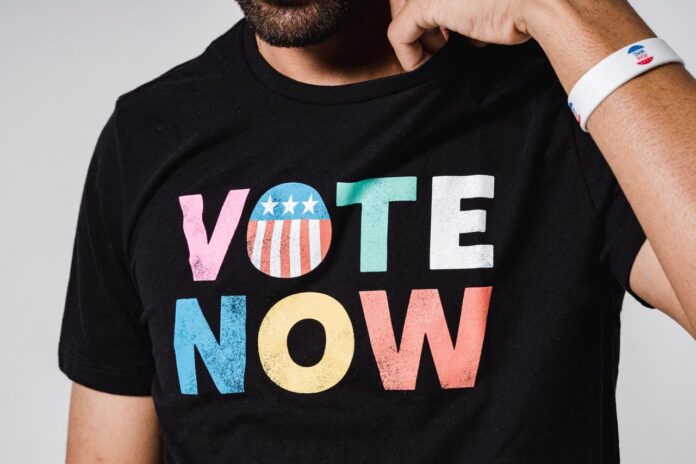Every two years, there is either a Presidential Election or a Mid-term Congressional Election. Every two years, approximately half of the undergraduate collegiate population we serve participates in their first National Election. Let that sink in for a second; approximately half of the students we serve during their collegiate experience will vote for the first time. This is why it is critically important, as student affairs professionals, we find ways to continue to increase dialogue and participation related to democratic engagement.
In 2012, the National Task Force on Civic Learning and Democratic Engagement of the Association of American Colleges and Universities, through its publication of “A Crucible Moment: College Learning and Democracy’s Future,” called on the United States of America to reclaim higher education’s civic mission, encouraging them to make civic learning and engagement more pervasive on their campuses (AACU, 2012). Over the course of the last forty years, voters ages 18 to 30 have represented the lowest percentage of voting participation rates compared to any other voting-age group (File, 2014; File, 2015). Participation hit an all-time low at 19.9% during the 2014 midterm elections (CIRCLE, 2015). Although both the 2016 and 2020 Presidential Elections and the 2018 Mid-term Congressional Election showed significant improvements in voter registration and participation rates over previous trends, participation among young people has consistently stayed lower than all other age brackets (File, 2018).
For many people, the term ‘democratic engagement’ has a bad reputation. Just mentioning the words will turn them away from a conversation, as they do not want to get into a debate with someone over a political issue. It’s important to note that democratic engagement can manifest itself in more ways than just voting. For some members of our communities, voting is not even an option, as they may not be eligible to participate. Although they likely use different terms, members of sororities and fraternities do civic engagement, civic learning, and democratic engagement all the time. The terms most often used are philanthropy, volunteering, or community service, but they are all means of engaging members in educational experiences to respect and appreciate diversity while also being socially responsible. It may also look like serving as Chapter President, a Council-wide Officer, or even in Student Government. There is nothing political when students are immersed in these high-impact learning experiences; rather, they provide the opportunity to combine knowledge and skills while working to improve the quality of life in our communities. With this in mind, a few questions remain:
- How do we move the students we serve beyond what they know?
- How do we get them to engage at higher levels beyond where they currently are?
- How do we work with our student leaders to engage others in the community?
- How do we redefine democratic engagement to a term that students are comfortable using?
To start the conversation, it is important to be on the same page when using terms such as civic engagement, civic learning, and democratic engagement.
Definitions:
- “Civic engagement means working to make a difference in the civic life of our communities and developing the combination of knowledge, skills, values, and motivation to make a difference. It means promoting the quality of life in a community through both political and non-political process” (Civic Responsibility in Higher Education, Ehrlich, 2000, p.vi).
- “Civic learning and democratic engagement means promoting the education of students for engaged citizenship through democratic participation in their communities, respect and appreciation of diversity, applies learning, and social responsibility” (NASPA, https://www.naspa.org/focus-areas/civic-learning-and-democratic-engagement).
With this context in mind, let’s turn our focus to how we move students beyond what they know and get them to engage at higher levels beyond where they currently are. When thinking about democratic engagement, there are three phases to consider; registration (if eligible), education, and participation. To be clear, one does not need to be able to vote to participate in democratic engagement.
Each state has its own procedures around voting. One of the easiest resources to use is TurboVote, a non-partisan application that makes registering to vote easy. The tool helps “guide voters through the registration process and/or helps them check their registration status, helps in starting the absentee or mail-in ballot request process, and sends text and email reminders about upcoming elections” (TurboVote, https://www.democracy.works/turbovote-about). When it comes to voter registration, it’s also important to consider if the student should register at school or at home. The Campus Vote Project has created a resource to help understand state-by-state information for registering and voting in all 50 states, which can be found at this link: https://www.campusvoteproject.org/state-student-voting-guides.
Next is education. When it comes to democratic engagement, there are several annual and national initiatives focused on increasing education related to democratic engagement. These include Constitution Day, National Voter Education Week, Ballot Parties, Debate Viewing Watch Parties, and other civic-dialogue programs. One such civic-dialogue program that helps engage students in reflective conversations that strengthen civic habits and engage in diverse perspectives is using the Ask Big Questions Civics Edition conversation guide. You can read more about how this guide was used to create a program, Ignite the Conversation, at the University of Illinois at Chicago. It’s through these educational programs we are able to help move the students we serve beyond what they know.
Last is participation. Although voting is the most direct way to impact democracy, there are a whole host of ways one can participate in democratic engagement without voting. These include serving as an Election Judge, becoming an advocate for an issue that is important to you and working with elected officials to address that issue, or volunteering for a community agency, candidate, or other important issue. Some sorority and fraternity community leaders even seek to run for public office to address these issues head-on, not to mention the items already outlined earlier in this article that members of our sorority and fraternity community are regularly doing in the community. It’s through these participation initiatives we can help engage the students we serve at higher levels beyond where they currently are.
Why is this important to someone working as a sorority and fraternity life professional, and what can they do to help/make a difference? This is of great importance to someone like you for several reasons. The first is that you have a captive group of highly engaged leaders. Our campus communities need sorority and fraternity leaders to help increase democratic engagement. The first step as a sorority and fraternity life professional is to understand what is already taking place on campus. More than 1,100 campuses are already participating in the National Student of Learning, Voting, and Engagement (NSLVE). If your campus is one of these campuses, work to find out who is leading the effort at your institution. If not, look for ways you can help support your campus in joining this study.
After determining if your campus is participating in NSLVE, the next logical step is taking the time to understand what efforts are already underway and how you can plug in the sorority and fraternity community to these efforts. If your institution isn’t already participating, a great resource to connect with is the ALL IN Campus Democracy Challenge. The ALL IN Campus Democracy Challenge connects institutions with 933 campuses across the country, all working toward the same goal of 100% participation in the democratic process. One of the greatest resources provided through participation in the challenge is a framework, Strengthening American Democracy: A Guide for Developing an Action Plan to Increase Civic Learning, Political Engagement, and Voter Participation Among College Students, to help establish a plan if your institution doesn’t already have one. With all that said, these are just a few examples of organizations doing this work, and it’s important to partner with those that fit your campus community and their needs.
Through these important steps of either joining in partnership with the folks on your campus leading these efforts or working on starting them, we will be able to work with the student leaders we serve to engage others in the community and help set the foundation for the next steps. In understanding what is already happening on your campus, you can work to find ways to engage sorority and fraternity members in what is already taking place. If it’s helping to create awareness and participation on campus, you can work to find ways to utilize the leadership of the Sorority and Fraternity community to pull in others from across campus. Additionally, being at the table to understand what is taking place will allow you to demystify the process and educate students that democratic engagement is as simple as registering, educating, and/or participating.
All sororities and fraternities have four things in common. They all strive to develop leaders, provide service back to their communities, promote high standards of academics, and create an environment of sisterhood or brotherhood. When members of sororities and fraternities participate in democratic engagement, they demonstrate their commitment to the values outlined. With our help, we can work to close the gap and work towards full participation of our members in this process and establish a lifetime commitment to democratic engagement.
About the author
Dr. Spencer Long serves as Sigma Alpha Epsilon Fraternity’s Chief Operating Officer. He is responsible for the oversight of chapter services, growth, accountability, and educational programs. As a student affairs professional, Spencer works to transform leaders and develop lifelong active citizens who work towards creating positive social change.
References
AACU: Association of American Colleges and Universities (2012). A crucible moment: College learning and democracy’s future. https://www.aacu.org/sites/default/files/files/crucible/Crucible_508F.pdf
CIRCLE: The Center for Information and Research on Civic Learning and Engagement (2015, July 15). 2014 youth turnout and registration rates lowest ever recorded. https://circle.tufts.edu/latest-research/2014-youth-turnout-and-registration-rates-lowest-ever-recorded
File, T. (2014, April). Young-adult voting: An analysis of presidential elections 1964-2012. https://www.census.gov/prod/2014pubs/p20-573.pdf
File, T. (2015, July). Who votes? Congressional elections and the American electorate: 1978-2014. https://census.gov/content/dam/Census/library/publications/2015/demo/p20-577.pdf
File, T. (2017, May 10). Voting in America: A look at the 2016 presidential election. United States Census Bureau. https://www.census.gov/newsroom/blogs/randomsamplings/2017/05/voting_in_america.html
File, T. (2018, September). Characteristics of Voters in the Presidential Election of 2016. https://www.census.gov/content/dam/Census/library/publications/2018/demo/P20-582.pdf


